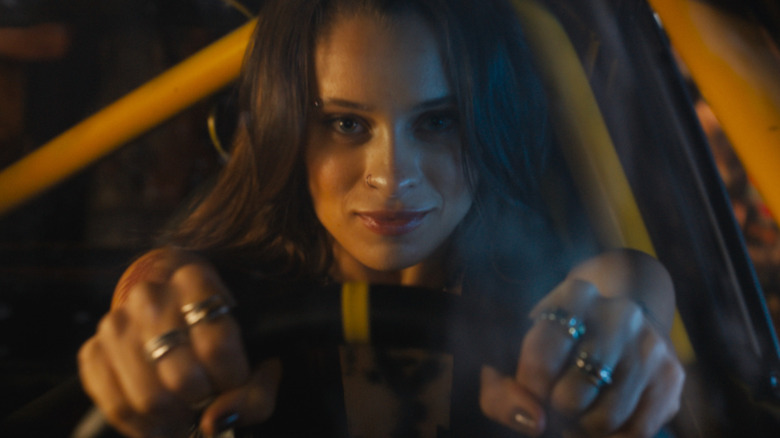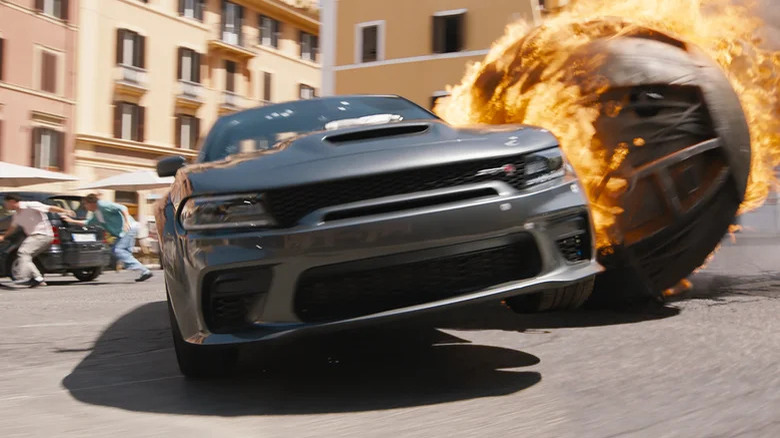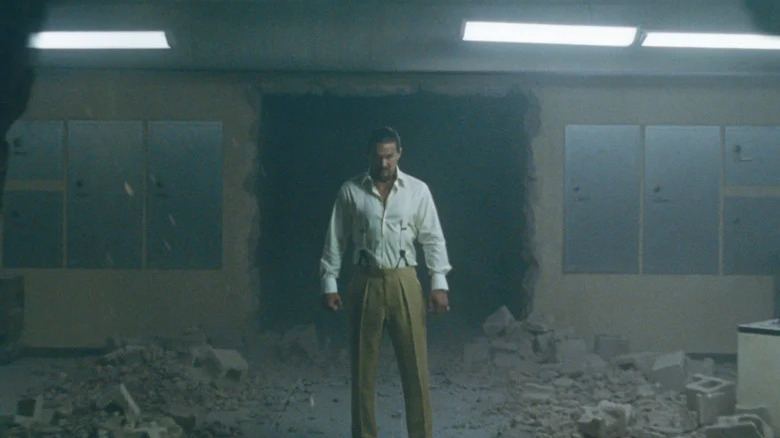Fast X's Best Action Scene Recreates One Of The Franchise's Greatest Moments
At the climax of Justin Lin's 2011 film "Fast Five," Dom (Vin Diesel) and Brian (Paul Walker) break into a bank in Rio de Janeiro with their souped-up muscle cars, attach cables to a massive bank vault belonging to a dangerous crime lord, and haul the entire 12-ton vault out into the street. Their cars are powerful enough that they can tow the vault at high speeds through the streets. Dom and Brian drive off, careening around corners, swinging the disembodied vault into storefronts or into pursuing police vehicles.
Not only is it one of the more astonishing action sequences in the series, but it proved to be a turning point for it as well. After "Fast Five," the "Furious" movies became larger and more elaborate than ever before, each chapter working hard to outstrip the last. Now, with "Fast X," the stakes are as high as they've ever been, and the action set pieces are now massively elaborate as a matter of course.
The film's writers, perhaps sensing that "Fast Five" was a high point in the series, spun the plot of "Fast X" directly from it. It seems that hidden within the vault-towing sequence was a previously unseen character named Dante (Jason Momoa), the son of the Brazilian gangster that Dom and Brian robbed. He came to resent that Dom and Brian left his family without cash and that his father has been killed in the scuffle. By "Fast X," Dante, a dandyish, mugging supervillain, finally had put a plan into motion that would leave Dom suffering.
Dante's first act of chaos involved the sloped streets of the Vatican and a spherical neutron bomb that acted like a giant bowling ball. That it is evocative of the vault sequence from "Fast Five" cannot be a coincidence.
It's a sphere this time
Early in "Fast X," Dante has lured several members of Dante's team — specifically Roman (Tyrese Gibson), Tej (Ludacris), Ramsey (Nathalie Emmanuel), and Han (Sung Kang) — to the Vatican under the pretenses that they'll be staging a heroic high-stakes heist from an armored truck. When they take the truck, they learn that it houses a massive, ball-shaped neutron bomb that they don't know how to defuse. Dante then blows the doors off the back of the truck, and the bomb rolls out, trashing the streets it barrels through and crushing anything in its path.
Dom arrives in one of his high-powered supercars and begins crashing into the bomb, attempting to push it away from people and toward a place where it might explode with minimal casualties. Because the chase is taking place on a slope, the ball only begins to roll faster and faster. At one point, it is set on fire. It's Vin Diesel vs. the flaming neutron ball. It's only a matter of minutes before the bomb reaches the center of the Vatican and explodes, killing the Pope and thousands of Catholic clergy members.
And that's not even the climax of the movie. That's just the first act!
Clearly, the filmmakers of "Fast X," in depicting a chase between fast cars and a marauding geometric shape, were trying to evoke the glories of the bank vault chase from "Fast Five." In both instances, cars were crushed and knocked aside by fantasy physics.
Simplify, simplify
Because physics are more of a polite suggestion in the "Furious" movies than a hard-and-fast scientific principle, the series' best action sequences tend to feature the heroes fighting the very force of gravity itself. In "Fast Five," it was twirling a bank vault. In "Furious 6," the heroes raced alongside a plane as it was driving down the world's longest runway. In "Furious 7," a car drove out of the 75th-floor window of a high-rise, plummeted through the air, and crashed into the window of the 70th-floor of the next skyscraper over. "Fate of the Furious" featured a literal rain of cars as they flew off of a parking structure. "F9" saw Roman and Tej launching a car into space.
There may have been bad guys in charge of some of the above scenarios, but the thrill of the "Furious" films is watching how Dom and his crew can bend the very laws of nature, merely because they happen to be good at driving cars. The series is most appealing when it's utterly ridiculous.
Putting "Fast X" and "Fast Five" next to each other was not just a plot decision, but a wise homage to the series' narrative fulcrum. That the giant ball should evoke the rolling cube is entirely appropriate.
"Fast X" ends on a cliffhanger of the most desperate type, with Dom in a situation so dire, one cannot imagine how he'll escape the scrape. If he retains his physics-bending powers, however, I'm sure he'll be fine for "Fast X, Part II."


